Wildfire Risk in the South – USFS Campaign
About this Campaign
This campaign, developed by the U.S. Forest Service Region 8, supports you in communicating wildfire risk in the South.
Possible Audiences
- Southern forest landowners
- Members of Congress
- Individuals who live in areas with wildland-urban interface
- Individuals who recreate on National Forest System lands
Communication Goals
- To raise awareness about the risk of wildfire in the South.
- To provide basic information about what the Forest Service is doing to reduce the risk of wildfire.
- To provide homeowners information about how to mitigate the risk of wildfire to their homes.
Target Dates
While wildfires can occur during any month of the year, wildfires in the South typically spike in the Spring. That’s because deciduous trees don’t have leaves, and weather conditions promote ignition and spread. With that said, wildfire happens throughout the year.
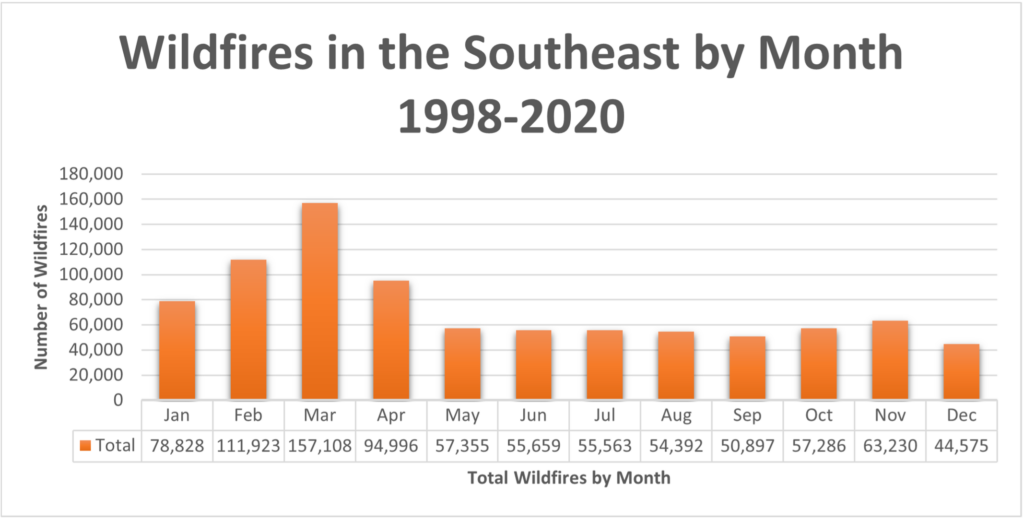
Background
Southern forests depend on fire. That’s because many of the trees that dominate our forests – including pine and oak – depend on fire to thrive, as do many plants that live beneath these trees. Historically, many forests in the American South would burn every two to five years, depending on the forest community type. The fire often was started by Native Americans or lightning. These fires kept the forests clear of undergrowth, allowing for a park-like understory of grasses and wildflowers.
Our work with prescribed fire (planned fires) seeks to mimic fire’s natural role in Southern ecosystems. These fires are intentionally ignited under certain conditions to reduce available wildfire fuels and lessen the chance of wildfire spreading.
Unfortunately, wildfires are growing in size and duration in the American South. The risk of wildfire has increased for a variety of reasons, including 1) an increase in flammable vegetation (caused by the exclusion of fire from forests beginning in the 1940s), 2) a changing climate, and 3) people building homes and communities in fire-prone landscapes, especially adjacent to the large forests, often called the wildland urban interface.
Resources
Elevator Speech
Believe it or not, the American South experiences more wildfires each year than any other region in the United States. While Western fires make the news because they are severe, it’s essential to know that Southern fires are becoming more common. That trend is significant because the South has three of the top four states with the most homes near wildlands, thereby creating more risk to human health and property. The Forest Service — in partnership with communities of people — is working to establish resilient forests and communities.
Key Messages
Believe it or not, the American South experiences more wildfires each year than any other region in the United States.
- The Southern Region – which includes 13 states, Puerto Rico and the U.S. Virgin Islands – leads the nation in the number of wildfires each year.
- In 2022, the American South experienced about 39,000 wildfires or 56% of the nation’s total.
- About 87% of our wildfires are caused by people, typically from escaped burn piles and arson.
- Most wildfires in the South start on private property, by people.
While Western fires make the news because they are severe, it’s important to know that Southern fires are becoming more common.
- A recent study by the National Oceanic and Atmospheric Administration suggests that the risk of very large wildfires in the South will increase by 300% by the middle of the century (2041-2070).
- Concerned scientists at the Forest Service’s Southern Research Station, say, “The southeastern United States is projected to experience increasing wildfire activity due to climate change.”
- You can read about the research here and here.
That trend is significant because the South has three of the top four states with the most homes near wildlands, thereby creating more risk to human health and property.
- We often talk about the “wildland urban interface.” That’s where homes and wildlands intermingle, thereby making fire a safety concern for communities.
- Since 1990, the wildland urban interface in the South has grown by more than 24.7 million acres.
- Today, more than 93 million acres in the South are in the wildland urban interface.
- Wildfire management is challenging and complex due to rapid population growth, an increase in the wildland urban interface, and a countryside with increasingly fragmented land ownership.
The Forest Service — in partnership with communities of people — is working to create resilient forests and communities.
- Wildfire does not follow ownership or management boundaries. Reducing wildfire risk means we must all work together – the Forest Service, our partners, individuals and communities.
- Working together, we can reduce the risk of wildfire in the South by:
- developing and implementing Community Wildfire Protection Plans;
- partnering with Community Mitigation Assistance Teamsto create more fire resilient communities and landscapes;
- helping individuals make their homes safer with programs such as Firewise USA; and
- actively managing Southern forests on federal, tribal, state and private lands with prescribed fire and other forest management tools.
- The National Cohesive Wildland Fire Management Strategy is a blueprint for sustaining and restoring healthy, resilient fire-adapted ecosystems; helping communities in fire-prone landscapes adapt to the inevitable wildland fires; and working together with our partners for a safe, effective, and appropriate response to wildfires.
- Did you know about 86% of the South’s 212 million acres of forested land is privately owned? That makes private landowners critical to reducing wildfire risk in the South.
- Treating the right landscapes, at the right scale, sustains healthy, resilient forests and reduces the risk of wildfire. The Southern Region’s efforts protects more than 58,000 communities and 89 million acres while also restoring longleaf pine, shortleaf pine and a variety of oak-dominated forests.
- We use the best available science and technology to foster the long-term health and resilience of America’s forests and grasslands.
-
- Fire is a natural part of the ecology of Southern forests. Historically, fire shaped the American landscape, and it continues to do so today.
- Research shows that prescribed fires, which mimic nature, and mechanical treatments are essential to mitigating wildfire risk.
- When wildfires happen in places already treated with prescribed fire, they are more likely to be smaller, easier to control and much less dangerous.
-
Example Press Release
Wildfire risk is high in the South
YOUR LOCATION – Mo., Day, Year – As temperatures rise throughout the South, and we see dry conditions, USDA Forest Service urges individuals to take steps to prevent wildfires at home and while recreating. In 2022, the South experienced about 39,000 wildfires or 56% of the nation’s total wildfires.
“Most people are shocked when they hear how many wildfires happen here in the South,” said (insert name of spokesperson).
Across the South, wildland firefighters work tirelessly to control wildfires and keep our communities safe.
(Name of fire POC on forest), a (title on forest), reiterated the importance of following statewide and county burn bans. During heightened wildfire season, residents should avoid burning within 150 feet of woodland or brushland. (Insert last name) recommends raking leaves and other yard debris out 30 feet from any buildings to minimize the risk of fire spreading to your home.
“Leaves and other dead plant debris are easy fuel for wildfires. Even with a bit of rain or fog in the morning, our warm, breezy days dry those smaller fuels out quickly and can give you a false sense of security when setting up a campfire or burning debris at home,” said (insert name), (insert title). “It’s important that Forest visitors and residents of our neighboring communities take precautions to ensure that fires, whether from campfires or debris burning, are completely out before leaving them unattended.”
On average, 87% of wildfires are caused by people. These fires happen when people burn debris, leave campfires unattended or even commit acts of arson. Fires also can be caused unintentionally by heat and sparks from vehicles and equipment.
Always remember Smokey’s message – “Only You Can Prevent Wildfires” – and use these precautions before heading out:
- Practice fire safety. Ensure campfires or pile burns, where permitted, are completely extinguished before leaving. Use the “drown, stir and feel” method before leaving a fire.
- Be cautious near dry vegetation. Do not drive, idle or park vehicles on dry vegetation. Hot exhaust pipes and mufflers can start fires.
For more information, visit (link to your national forest website) or follow (name of Forest) on Facebook (www.facebook.com/forestFacebookLink) or Twitter (twitter.com/forestTwitterlink).
###
USDA is an equal opportunity provider, employer, and lender.
Social Media Content
- #DYK 56% of all wildfires 🔥 reported last year occurred across the South? Learn more about #wildfire risk https://www.fs.usda.gov/managing-land/fire/wildfireris
- Oxygen. Fuel. Heat. That’s all it takes to keep a wildfire 🔥 going. Learn more about #wildfire risk https://www.fs.usda.gov/managing-land/fire/wildfirerisk
- #DYK about 87% of wildfires in the South are caused by people. Think burning debris, unattended campfires or arson. 🔥 also can be caused by heat and sparks from vehicles and equipment. #PlaySafe while outdoors, and do your part to prevent #wildfires.
- In the South, 87% of our #wildfires are human caused (insert Smokey Bear’s voice: #OnlyYou). Help protect the forest, and all the creatures who call it home! 🦝🐇🦌 🦇🦋 When headed outdoors, remember to practice #LeaveNoTrace and follow our friend #SmokeyBear for wildfire prevention tips. Learn more at smokeybear.com
- The South has three of the top four states in the nation with the most homes near nature – which creates increased wildfire risk. #DYK there is a term for this area where people live near forested lands? It’s called the wildland urban interface, a.k.a. WUI (pronounced: woo-wee).
- Did you know there is a real-time map to show your #wildfire risk by location here in the South? Simply type in your address and find out now. https://www.southernwildfirerisk.com/Map/Public/#whats-your-risk
- Healthy Forests = Beautiful Forests. The health of our Southern forests depends on active forest management. Active forest management is:
- reforestation to help grow a new generation of healthy forests,
- prescribed fires to reduce the likelihood and impacts of uncontrolled #wildfires,
- timber harvesting to reduce overcrowding of vegetation, which is fuel for #wildfire,
- weed and pest control to improve tree health.
- Choose local photo to illustrate the text
- Whether you live near a forested area or a bustling city, our everyday lives are affected by forests. Forests affect the quality of air we breathe and water we drink. Healthy forests are also less likely to have devastating, catastrophic #wildfires.
-
- Choose a local photo to illustrate the text
- How many days of the year do we spend fighting #wildifire in the South? 300. Do your part to reduce the risk of #wildfire in the South. https://www.fs.usda.gov/managing-land/fire/wildfirerisk #forestproud
Social Media Content
- Our changing climate means #wildfires are becoming more frequent and intense. Our changing climate can drive temperatures higher, which can cause more severe droughts, create gustier winds, drier soil and weaker trees. All these factors contribute to ⬆️ an increase in #wildfire risk.
- Forests offer powerful climate solutions. Forest management is how we deliver them. Managing forests for climate means understanding the role of fire in all its forms: wildfires, catastrophic megafires, and good fire through prescribed fires. https://www.fs.usda.gov/themes/mitigate-wildfire-risk #ForestHealth #forestproud
Social Media Content
- We love a campfire, but check your local fire restrictions before you light one. 🔥 Use existing fire rings, keep campfires small, and ensure they are completely out and cold to the touch before leaving. #PlaySafe to reduce the risk of #wildfire https://smokeybear.com/
- What is your community’s risk for a #wildfire? Help your community better plan and prepare for wildfires through a new tool we developed. https://www.fs.usda.gov/managing-land/fire/wildfirerisk
- Wildfires can produce a lot of smoke. Check the AirNow fire and smoke map, available in Spanish and English, to see your air quality – and steps you can take to help keep the air clean. Learn more at https://fire.airnow.gov/
- Take action to mitigate your risk of #wildfire! People often feel powerless against wildfires. But, you can prepare. The first step is understanding your risk of wildfire. Find out more now https://www.southernwildfirerisk.com/Map/Public/#whats-your-risk
- Every year, devastating #wildfires burn across the United States. At the same time, a growing number of people are living near nature. While these fires will continue to happen, there are things you can do to protect your home and neighborhood as well as your family’s safety. The Firewise USA® program can help you get started. https://www.nfpa.org/Public-Education/Fire-causes-and-risks/Wildfire/Firewise-USA
- Our Southern, beautiful locales are where more and more people call home. In fact, three of the top four states in the nation with the most homes near nature are in the South. To help with costly fire mitigation efforts, the Forest Service has launched a $1 billion Community Wildfire Defense Grant program to help communities most at risk. Does your community qualify for a Community Wildfire Defense Grant? Find out at https://www.fs.usda.gov/managing-land/fire/grants.
- The Forest Service strives to help create strong fire-adapted communities. That does not mean that they are fireproof. But these communities are prepared for, and adapted to, living with fire. To learn more visit: https://www.fs.usda.gov/inside-fs/delivering-mission/sustain/community-coalition-provides-fire-prevention-education
Here is how to protect yourself if #wildfire smoke is in the air:
✅ If it looks or smells smoky outside, take it easier to reduce how much smoke you inhale.
✅ Choose a mask that will help protect you from smoke. N95 respirator masks provide the best protection from wildfire smoke.
✅ Limit time spent outdoors. Only performing essential activities and take frequent breaks indoors.
✅ Reschedule outdoor work tasks.
Social Media Content
- Know before you fly. Using unauthorized unmanned aerial systems, or drones, in a fire area endangers the lives of pilots and firefighters. Never fly unmanned aircraft over or near a fire. If you fly, we can’t. http://www.knowbeforeyoufly.org/avoid-wildfires
- Remember, a temporary flight restriction (TFR) is in effect between ________. All fire aviation stops if an unauthorized aircraft enters the TFR. Even if you are flying just outside the TFR, this can put unnecessary pressure on pilots and air traffic control to increase their vigilance. TFRs also apply to unmanned aircraft systems or drones. If you fly, we can’t! #[FireName] #UAS #Drones #WildfireUAS #IfYouFlyWeCant #WildfireSafety
- Firefighting aircraft and UAS both fly at very low altitudes. When unauthorized UAS fly over or near wildfires, a mid-air collision or pilot distraction could result in a serious or fatal accident. Unauthorized UAS could also lead fire managers to suspend aerial wildfire suppression operations, such as retardant and water drops. #[FireName] #UAS #Drones #WildfireUAS #IfYouFlyWeCant #WildfireSafety
- Suspending air operations could decrease the effectiveness of wildfire suppression operations, allowing wildfires to grow larger, and in some cases, unduly threaten lives, property and valuable natural and cultural resources. We ask the public not to fly UAS near or over a wildfire: “If you fly, we can’t.” #[FireName] #UAS #Drones #WildfireUAS #IfYouFlyWeCant #WildfireSafety
- Drone operators who ignore temporary flight restrictions near wildfires cause real problems: [describe recent incident]. The federal government has rules against flying drones that interfere with wildfire suppression efforts. Violators can be fined up to $25,000 and criminal prosecution. #[FireName] #UAS #Drones #WildfireUAS #IfYouFlyWeCant #WildfireSafety
Graphics
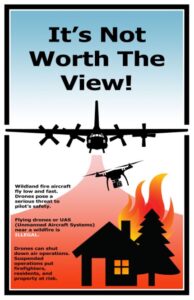
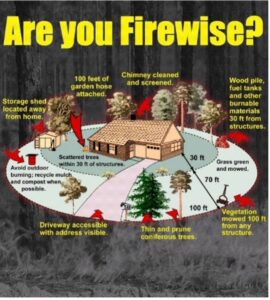
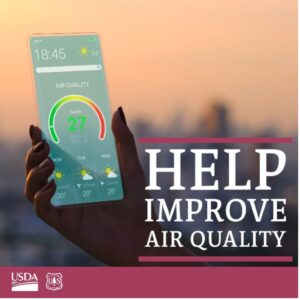
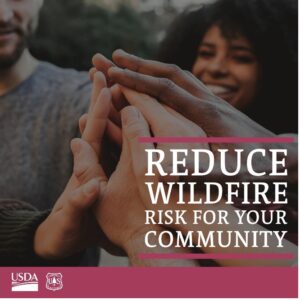
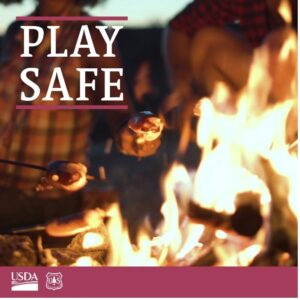
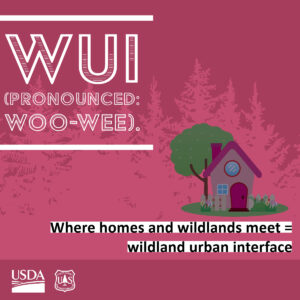
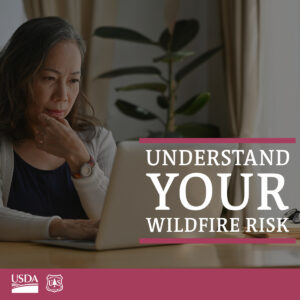
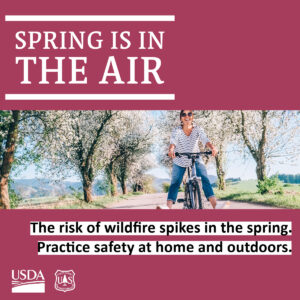
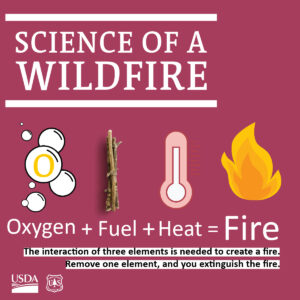
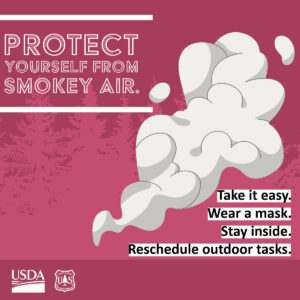
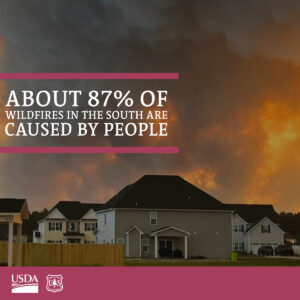
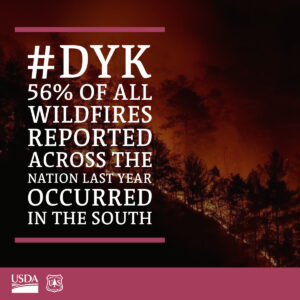
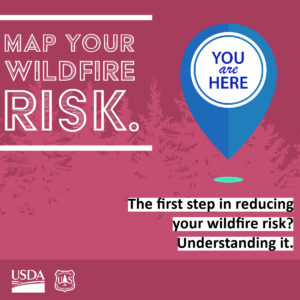
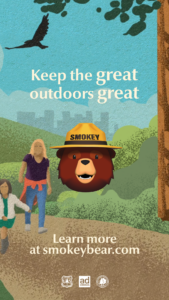
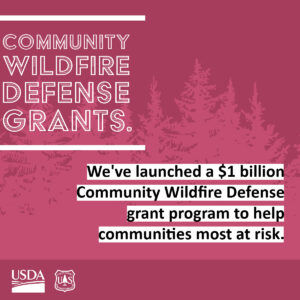
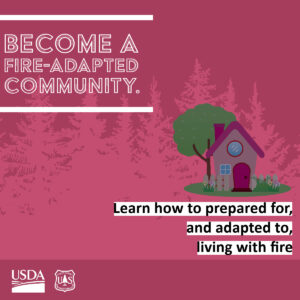
Hashtags
#Wildfire
#HealthyForests
#ForestProud
#PlaySafe
Photos
Flickr: Forest Service Fire Album
Flickr: Wildfire threats to communities
*Within this campaign, we recommend using imagery that can personalize wildfire risk in the South
Related Toolkits
- Reducing Wildfire Risk – SGSF Webpage
- 2023 Wildfire Communication – WO Toolkit
- Agency Readiness – WO Toolkit
Congressional Messaging
- Wildfire is driven by three main factors — weather, terrain, and fuels. When fighting wildfires, firefighters work to reduce the fuel feeding the fire, either by removing it with heavy equipment, handlines, or by making it hard to burn by soaking the fuel with water or retardant.
- When reducing fire risk to communities, land managers take the same approach across landscapes to reduce vegetation or fuels, including brush and dead and down trees. Fuels reduction projects are a critical step to helping protect homes, businesses, and recreation sites from destructive wildfires.
- The Joint Chiefs Landscape Restoration Partnership between the Forest Service and Natural Resources Conservation Service aims to restore landscapes, protect water quality, enhance habitat, and reduce wildfire threats to communities and landowners nationwide.
- While many of our [insert unit] staff are away from home serving on the front lines of western wildfires [and/or other emergencies elsewhere], Forest Service employees who remain on the home unit do their best to keep our local facilities and programs working.
- Our units become considerably understaffed when employees mobilize for incident response. Your constituents may notice changes in the level of service we provide.